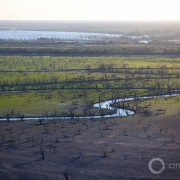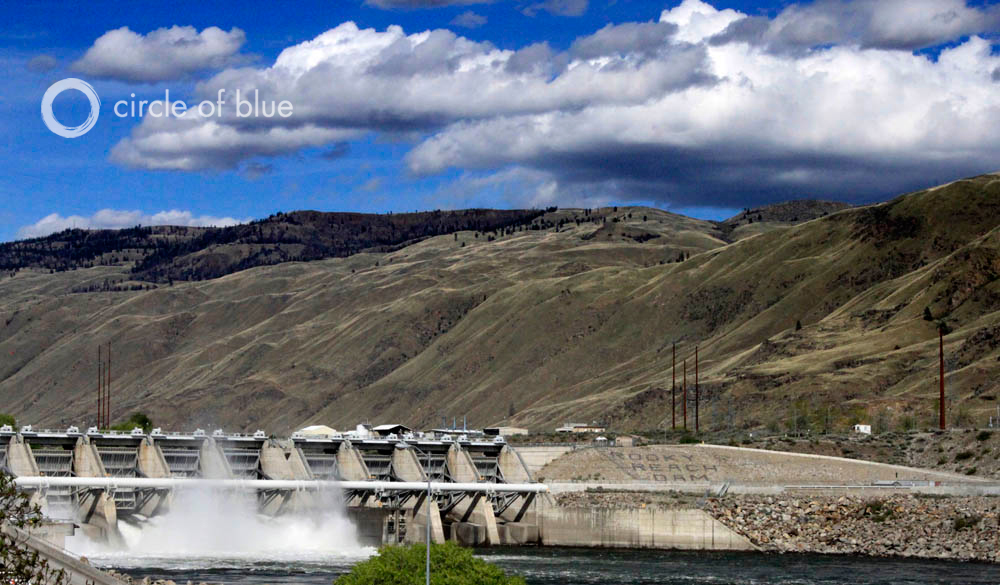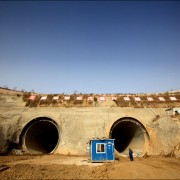Digital Controls Improve Energy Efficiency at Colorado River Dams: Davis, Hoover, Parker
Mechanical parts from the 1950s are being replaced with digital controls at three dams.
By Brett Walton
Circle of Blue
In the next few weeks, U.S. Bureau of Reclamation managers will install a digital control system in the fifth turbine unit at Davis Dam on the lower Colorado River, completing a series of renovations started last fall to improve operating efficiency at the 60-year-old facility.
The mechanical parts being replaced—most as old as the dam itself—are getting a modern touch.
A digital system for the voltage regulators, electrical governors, and control panels will give dam managers more command over the system and allow them to position with greater accuracy the wicket gates that regulate water flow into the power plant’s turbines.
The goal for these system improvements is to increase the productivity of every drip of water behind the dams. While hydropower is already the most energy-efficient way to produce electricity, there is greater urgency to make the dams more effective. Each drop counts as electrical demand in the Southwest rises and output at Hoover Dam falls—a consequence of less water in Lake Mead.
Davis Dam, which straddles the Nevada-Arizona border, is one of three hydroelectric plants undergoing renovations along the lower Colorado River. Unlike the upstream Hoover Dam, a shrinking reservoir is not a concern at Davis, where water levels stay within a 10-foot band due to a steady water supply from legally-mandated releases from Lake Mead.
Unit upgrades will begin in October at Parker Dam, located 88 miles downstream from the Davis. At Hoover Dam, new turbine wicket gates and digital controls were installed last summer and high-efficiency turbines will follow next year.
The upgrades will not add generating capacity. Rather, they allow the plants to convert more of the potential energy stored in the reservoirs into electrical energy. Figures aren’t yet available for the Davis project, but at Hoover, energy efficiency has increased 4.3 percentage points post-renovation to total 84.3 percent, according to the Bureau of Reclamation. Comparatively, average energy efficiency for a traditional coal-fired power plants in the U.S. is 32.5 percent, according to a report from the U.S. Department of Energy.
Managers at the 255-megawatt Davis Dam have already noticed quicker response time from the digital governors in the four units in which construction is complete. The governors allow the units to be operated for maximum generation.
“We can more quickly ramp up and down power output,” said Dave Arend, head of power management at the Bureau of Reclamation’s Lower Colorado office. “It’s more effective to run two fully loaded units than three partially.”
The digital controls also help move the turbines through rough zones faster, Arend told Circle of Blue. Rough zones happen when units run in the middle of their generating range. In this zone, vibrations increase and the units have a greater risk of being damaged from air bubbles exploding in the passing water stream.
Financing for the dam upgrades comes from power users in Arizona, southern California, and southern Nevada.
Brett Walton is a Seattle-based reporter for Circle of Blue. Contact Brett Walton

Brett writes about agriculture, energy, infrastructure, and the politics and economics of water in the United States. He also writes the Federal Water Tap, Circle of Blue’s weekly digest of U.S. government water news. He is the winner of two Society of Environmental Journalists reporting awards, one of the top honors in American environmental journalism: first place for explanatory reporting for a series on septic system pollution in the United States(2016) and third place for beat reporting in a small market (2014). He received the Sierra Club’s Distinguished Service Award in 2018. Brett lives in Seattle, where he hikes the mountains and bakes pies. Contact Brett Walton








Great article on how digital controls have been implemented to improve energy efficiency at Colorado River dams. It’s amazing to see how technology can be used to increase the efficiency of such large-scale operations. It’s encouraging to see that energy efficiency improvements are being made across various industries, and it’s important that we continue to find ways to reduce our energy consumption and environmental impact.